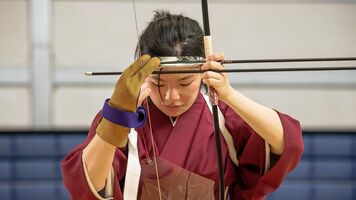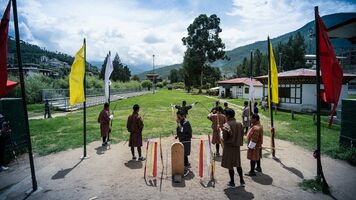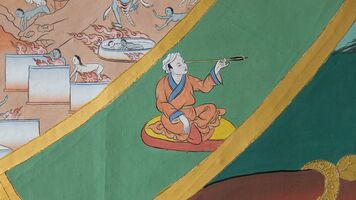An Olympic flagbearer: In the Land of the Thunder Dragon

This is part two of a three-part series called In the Land of the Thunder Dragon exploring the culture of archery in Bhutan. Part one is Archery is in our blood and part three is Tradition, religion and identity.
Karma stands with her teammates on Bhutan’s sole Olympic archery range, and shoots a quiverful of Easton X10 arrows at 70 metres, as she does all day, every day, six days a week.
The wind gently rustles the trees overlooking the range. There are the familiar sounds of recurve practice, as a stray dog lies on the shooting line and yawns. We’re all drinking sweet chai tea, and it’s drizzling rain.
I’m at the headquarters of the Bhutan Archery Federation.

The national Olympic team train on a range set into the mountainside by the burbling Thimpuchuu river, a tributary of a river system that eventually reaches both India and Bangladesh. The range is a short distance from Thimphu, past houses with roofs covered in drying red chilis.
It benefits from glorious views, brooding skies and fresh air, although two months of monsoon rain a year aren’t so helpful, and it’s not uncommon to see Himalayan black bears on the field.
“We had one the other week,” says national coach Tashi Tshering. “But it wasn’t that big. Maybe 125 kilos?”
He laughs, stretching his arms wide.

Watching the archers train, I get to speak to the president of the federation, Ugyen Rinzin, who is a key part of both worlds of Bhutanese archery. I ask him: “Why is archery the national sport?”
“It’s been played throughout the country for centuries,” he says.
“There’s history, culture and a lot of pride. Everywhere. Village to village, local rivalries. It’s just so infused into the Bhutanese culture, that if you grew up here it’s something you just see adults playing.”
“There’s a lot of colour and drama to the sport. As children, everyone learns how to make your own bow and arrows. It’s the one sport that people just grow up with.”
There isn’t much crossover between the world of traditional archery, managed by a separate federation, and the target teams.
“There’s a marked difference between the two,” says Rinzin. “But we’re trying to create more synergy between them. It’s been an interesting challenge for us.”

Recently. there has been an ambitious government programme to try and introduce Olympic archery to Bhutan’s schoolchildren - all of them.
“At a young age, girls and boys play archery, but later when it develops into tournaments and so on, it becomes a men’s sport. But the schools programme we have initiated, we’re finding it’s more like equal numbers of girls and boys participating,” he explains.
Bhutan’s elite system currently supports six recurve archers, a handful of part-time compound archers, and a single para-archer.
The recurve team are supported as full-time athletes, but commit to a punishing five-and-a-half days a week schedule that would shame many elite squads around the world.
The archers assemble at 5h30 every day for cardiovascular exercise, shooting and training until 18h00 in a carefully scheduled program that includes stretching, yoga and meditation.

They eat breakfast and lunch at the range, and train outdoors, year round (indoor shooting of any kind is unknown in Bhutan).
I have to ask: “How do you survive a punishing schedule like that?”
“Oh, it’s OK”, says Karma. “I mean, I sometimes jog to the range, too.”
As I visit, the team are preparing to go to Japan for a tournament, and have stepped up their training to include a mixed team round.
Karma, who received a tripartite place to participate in the Olympics in 2016, was one of just two Bhutanese athletes to go to Rio for the Games.
Since the country’s Olympic debut in 1984 in Los Angeles, the Olympic committee only sent archers to every Games up until 2012. In London, they were represented by one female archer and one female shooter - a pattern repeated in Rio.
Karma got to carry the flag at the opening ceremony in the Maracana stadium because of the medals she had won at the South Asian Games in 2016 (her fellow Olympian got to carry it at the closing ceremony). She followed in the footsteps of several Bhutanese Olympic legends, including former national coach Tshering Choden, who competed in two Games and notably knocked out one of the Chinese favourites on home turf in Beijing.

In Rio, Karma’s single match was against world team champion Tuiana Dashidorzhieva.
The organising committee computer system could not cope with her single name, and she was announced to the world as ‘Karma Karma’. In front of the Crown Prince of Bhutan, she fought hard, splitting three sets with the Russian archer before a tricky fourth end saw her lose three points to seven.
“Win or lose, I want to compete with champions,” she said afterwards.
“Before I represented my country in Rio, most of my friends and family didn’t really recognise what I was doing.” she said, but now: “Sometimes,” she blushes.
Her teammate Sonam Deki has been on the squad since 2014, plucked from a tryout session as a promising athlete.
“In Bhutan, usually, women don’t play archery,” she says. “Old people would say: ’It’s not good [for women] to play archery.’ Coming here was the first time I saw a woman with a bow. It was awkward at first, but afterwards it felt awesome.”
She dreams of a Bhutanese women’s team competing in the Olympic Games in the future, for the first time since 1992.

The senior male recurve on the squad is Kinley Tshering, known in World Archery circles for using a pink bow given to him by Brady Ellison, which he used to make the last 16 at the 2014 Asian Games.
He no longer has it: “I got a new one. But my new one is pink, too.”
This afternoon, there is also a large gathering of some of the best traditional compound archers, a meeting called to encourage them to participate in a 50 metre tournament held here under World Archery rules.
There are bows up for grabs, cash prizes, and an opportunity to represent Bhutan internationally. It’s one of several recent initiatives with the long-term goal of harnessing the dedication and effort put into traditional archery and straightening it up into a compound target team that is capable of taking international medals.

Bows are shown off and tweaked. Backs are slapped. There’s a lot of testosterone in the room.
The slideshow display makes several notes specific to the audience; warnings about alcohol and other intoxicants, and the idiosyncratic sky draws often seen on the ranges.
It finishes with a lot of discussion about release aids, which are uncommon in Bhutan. There’s a lot of folded arms, but you can also feel a sense of not wanting to miss out.
Things are slowly changing.
John Stanley’s three-part In the Land of the Thunder Dragon series explores the culture of archery in Bhutan. Part one is called Archery is in our blood, part two is An Olympic Flagbearer and part three is Tradition, religion and identity.





